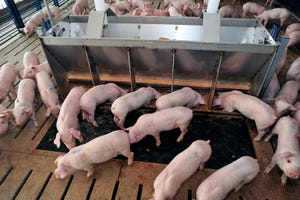Increasing the value of manure
High water content in manure makes it expensive to move.
April 6, 2021

Manure is a valuable fertilizer for crop production. However, it gets expensive to move very far from the barn because of its high water content. Here are four tips to get the most out of your manure:
Test it. The manure's value is mostly in nitrogen, phosphorus, and potassium. Knowing what you have is the first part of determining where to put it. Nitrogen and potassium are water-soluble and predominately dissolved in the liquid fraction. Phosphorus is enriched in the solids fraction. Look closely at the solids content of the manure sample. The solids content as excreted from a pig is approximately 13%. Most swine deep-pit manure samples are between 5-10% solids. If your sample has low solids content, look for water waste. Particularly, assess if you can modify the cleaning and the power washing methods to reduce wastewater production. While it is important to thoroughly clean for biosecurity, extra water use increases manure water and costs more to haul.
Test the soil. Figure out where the soils are low in phosphorus and where high and very high phosphorus levels exist. On many livestock farms, phosphorus levels are higher closer to the farmstead and much lower farther away. Newly acquired farms are often lower in soil phosphorus. They are prime candidates to apply manure with high solids content to build phosphorus levels. Mapping and planning where fields need phosphorus will ensure you get the nutrients to the areas that need them most.
Manage the agitation. Because the liquids have a lower concentration of phosphorus, apply the first loads out of the pit without agitation. These loads will have higher N:P ratios and should be applied to the crop's nitrogen needs. When the manure pit is about half to two thirds full, start agitation. Make sure to start agitation soon enough that sufficient liquid is present to suspend the remaining solids. These later loads will often have two- to three-fold higher concentrations of phosphorus, and the higher nutrient content makes it more cost-efficient to haul to distant fields or build fertility in low testing parts of a field. Care must be taken when this agitation starts to prevent pit gas problems, and the ventilation needs to be increased.
Measure your success. Take samples of the un-agitated early loads to see the manure nutrient content and compare it to the later agitated loads. Comparing samples will let you see how nutrients are being concentrated. Take soil samples to see the changes made in soil fertility. Twenty pounds of phosphorus per acre should raise the soil test by one ppm. Measure the yield and watch crop response.
Source: Daniel Andersen, who is solely responsible for the information provided, and wholly owns the information. Informa Business Media and all its subsidiaries are not responsible for any of the content contained in this information asset.
You May Also Like



